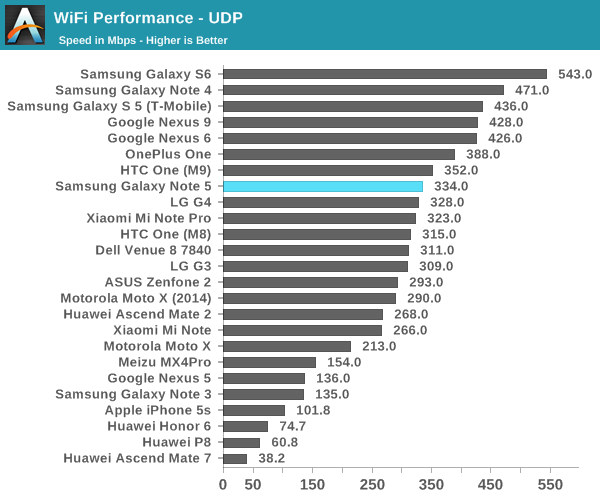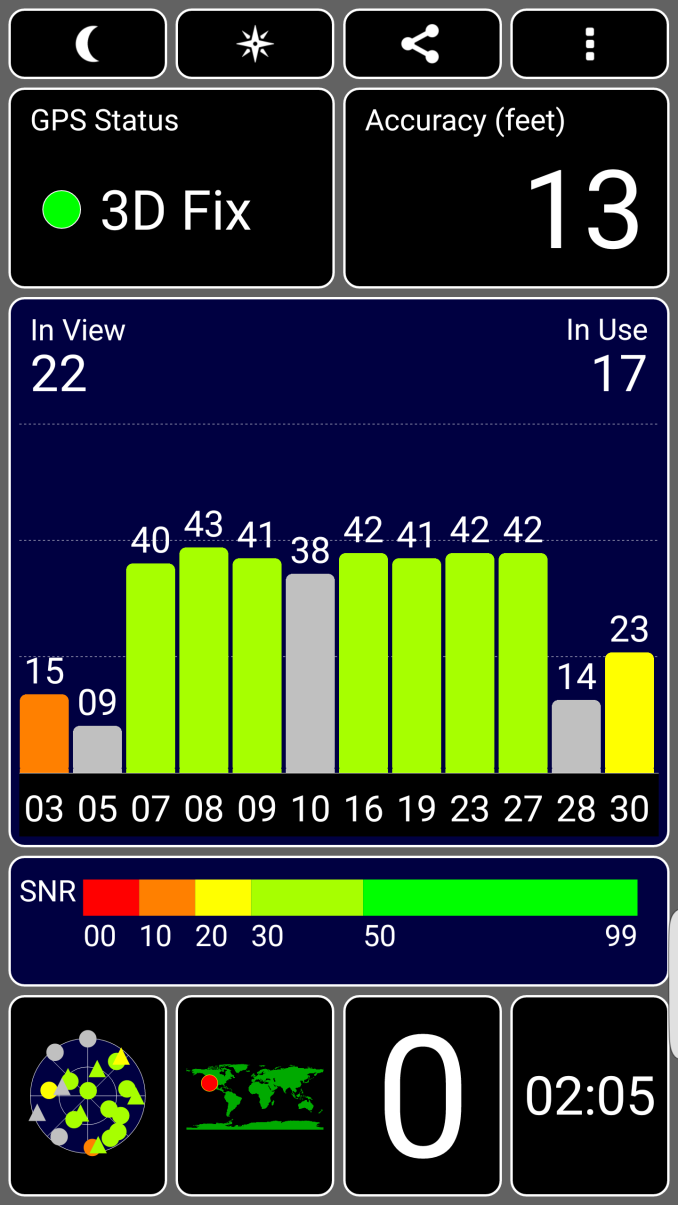The Samsung Galaxy Note5 and Galaxy S6 edge+ Review
by Joshua Ho on October 2, 2015 8:00 AM ESTVideo Performance
Now that we’ve taken a look at still image performance, we can look at video performance. For the most part these results should be similar to still image performance, but we’re looking at encoder efficiency, good sound recording, and effective stabilization. The Galaxy Note5 and Galaxy S6 edge+ both have OIS in order to improve stability in video recording, and for the most part the feature set of both is similar to the Galaxy S6 when it comes to video.
Galaxy Note5
Galaxy S6
Galaxy Note5
iPhone 6
For 1080p30, Samsung has elected to use 17Mbps High Profile H.264, along with a 256 Kbps stereo audio channel encoded with AAC. If this sounds familiar, it's because this is shared with the Galaxy S6. Quality is indistinguishable. Unfortunately, it seems the same sort of jerky OIS reset effect is still present although it isn't too obvious in these videos.
Galaxy S6
iPhone 6
It probably goes without saying, but once again the Galaxy Note5 shares the same video encode settings with the Galaxy S6, with 28 Mbps High Profile H.264 encoding for 1080p60 video. In these samples you can more clearly see the issues that come with OIS in video, which is that there are instances of jerky video movement when it should be relatively smooth, even if it's shaky. The only real difference between the Galaxy S6 and Note5/S6 edge+ is that the Note5 removes a bit of the yellow tinge/saturation boost that we see in the Galaxy S6. There's otherwise relatively little to comment on here.
Once again, not much is different when comparing the Galaxy Note5 and Galaxy S6 edge+ to the Galaxy S6 other than saturation differences in some cases. The same encoder settings are also used for 48 Mbps HP H.264 with 256 Kbps AAC stereo audio.
Galaxy Note5
Galaxy S6
Galaxy Note5
iPhone 6
If you're able to read the trend, you can probably guess that the Galaxy Note5 and S6 edge+ are going to share the same encode profiles as the Galaxy S6, which is 48Mbps HP H.264. Once again, quality is effectively identical here and the changes are slim to none. This unfortunately means that the iPhone 6 still leads here as the quality of the slow motion video on the Galaxy Note5 and Galaxy S6 line weren't much good to begin with.
WiFi Performance
For the most part, it probably goes without saying that one of the cornerstones of a smartphone or phablet is mobile data. After all, without mobile data you’re effectively limited by whatever WiFi hotspot you can find, which is often limited in range. Comparatively speaking, mobile data is generally more versatile. However, in the case of most mobile devices WiFi is often used at home in order to utilize a normally lower-latency connection with generally higher throughput. Given the reality of data caps, WiFi is also often needed for things like app updates, video streaming, and possibly music streaming. As a result, poor WiFi can sink a phone. In order to try and get a basic measure of performance, we look at peak UDP bandwidth using iPerf. In the case of the Galaxy Note 5, Samsung has upgraded the WiFi chipset from the BCM4358 used in the Galaxy S6 to Broadcom’s BCM4359. This is supposed to allow connections to 2.4 and 5 GHz WiFi simultaneously, but in practice it doesn’t really look like it’s used outside of potentially faster scanning.

Interestingly, I was unable to get the download speeds that I was expecting from a 2x2 802.11ac WiFi solution despite using 5 GHz. It's possible that this is due to interference as I can't isolate the system from other WiFi hotspots in the area, but in my experience I never had any real issues with WiFi that I could notice. Reception doesn't seem to be any better or worse than other devices I've tried in recent memory.
GNSS Performance
GNSS is often critical to a mobile device these days, as a number of applications rely on highly accurate location in order to work properly. Probably the most obvious case here is going to be GPS navigation, but things like lost/stolen device location, geofencing, location-based check-ins, and other applications are all generally quite reliant on accurate location that only GNSS systems can provide. In the case of the Galaxy Note5 and Galaxy S6 edge+, we see that the GNSS module is shared with the Galaxy S6 for the Shannon modem variants as a BCM4773 GNSS location hub is present within the system.
In practice, I didn’t find much wrong with this solution. Time to first lock without any assistance data took about 30 seconds, and at the 46 second mark the maximum possible accuracy was achieved. With assistance data, a position fix was reported within 5 seconds of launching the GPS Test app. Overall, I doubt anyone will face any real problems dealing with GPS/GNSS location on these devices.











225 Comments
View All Comments
ciderrules - Tuesday, October 6, 2015 - link
Funny you picked the iPhone 6S and not the 6S Plus, which is a better comparison due to it having a larger screen and more "pixels to push".It scored 85 hours on their endurance rating, easily beating the GS6's 73 hours. Further, the 6S Plus beat last years 6 Plus even with a smaller battery. GS6 actually had less battery life than the GS5.
So Apple gives you the most powerful processor on the planet, decreases the battery size by 8%, and manages to increase battery life.
Kuzi - Tuesday, October 6, 2015 - link
iPhone 6s Plus is a phablet the same size of the Note 5, so should be compared with the Note 5 which gets the same rating of 85 too, but is pushing 1.7 times more pixels while offering faster multithreaded performance.ciderrules - Tuesday, October 6, 2015 - link
No, it's not faster. I already explained this to you before and you're still coming back and posting incorrect information again?Primate Labs (makers of Geekbench) rates the Note5 at 4351, the iPhone 6S/6S Plus at 4330/4331. So yes, the Note5 is a fraction of a percent faster in multi core performance.
Kuzi - Wednesday, October 7, 2015 - link
How many times do I have to explain that I own a Galaxy S6 and I get +5200 on Geekbench multicore test. I also own an Xperia Z4 tablet (SD 810 based) that gets +4800. So both are faster than A9 in multicore.Also GSMArena & Phonearena get similar results for exynos 7420 based devices as per below:
http://www.gsmarena.com/samsung_galaxy_note5-revie...
http://www.phonearena.com/news/Our-Samsung-Galaxy-...
There is some variance with each test run, and if the phone is warmer it gets slightly lower results. In my case the lowest I got was 5000 for GS6.
thedons1983 - Sunday, October 18, 2015 - link
What a fucki#g moron. You are pathetic!!coburn_c - Sunday, October 4, 2015 - link
Both curves of the plus have a disgusting green hue to them, and when you tilt it until one disappears, the entire front gets the baby poo greens. It is easily the worst viewing angle on any modern phone, and on an AMOLED of all places, a technology known for its viewing angles. I can't imagine how they could have screwed up worse.thedons1983 - Sunday, October 18, 2015 - link
Then you lack imagination... Apple has already made a worse phone for starters, or are you so ignorant, that you can't tell the difference between apples and oranges????theduckofdeath - Monday, October 5, 2015 - link
I wonder why Anandtech still had one standard for Samsung and one standard for everybody else when it comes to displays? I don't see you people scrutinise and down rank ocular quality issues with LCD displays like to do with AMOLED. AMOLED haven't just caught up to LCD this year, it's been superior for years, Anandtech. Fix your flawed and biased tests.Peichen - Monday, October 5, 2015 - link
If AMOLED is anywhere close to IPS why aren't EIZO, NEC, Dell switching their professional lineup to AMOLED? Why are 31" calibrated IPS monitors going for $3000 while the same money can get you 55" 4K OLED TV? For that matter, how come no one is selling a calibrated OLED anything? With all the green/purple tint and grayish white you'd think OLED could use some calibration.Leave the review to the professionals. Your eyeballing review aren't worth the hot air carrying the sound bits.
Kamus - Tuesday, October 6, 2015 - link
"The professionals" agree with him, go read displaymate's reviews.